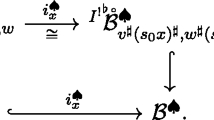Abstract
We prove that for any normal toric variety, the Rouquier dimension of its bounded derived category of coherent sheaves is equal to its Krull dimension. Our proof uses the coherent-constructible correspondence to translate the problem into the study of Rouquier dimension for certain categories of constructible sheaves.
Similar content being viewed by others
Notes
We are not sure if this list is exhaustive.
For completeness, we give the reference to the stacky case. The original proof (for schemes) is due to Rouquier [29, Proposition 7.17].
References
Bai, S., Côté, L.: On the Rouquier dimension of wrapped Fukaya categories and a conjecture of Orlov. Compositio Math. 159(3), 437–487 (2023)
Ballard, M.R., Duncan, A., McFaddin, P.K.: The toric Frobenius morphism and a conjecture of Orlov. Eur. J. Math. 5(3), 640–645 (2019)
Ballard, M., Duncan, A., McFaddin, P.: Generation and the toric Frobenius (in preparation)
Ballard, M., Favero, D.: Hochschild dimensions of tilting objects. Int. Math. Res. Not. IMRN 2012(11), 2607–2645 (2012)
Ballard, M., Favero, D., Katzarkov, L.: Orlov spectra: bounds and gaps. Invent. Math. 189(2), 359–430 (2012)
Ballard, M., Favero, D., Katzarkov, L.: A category of kernels for equivariant factorizations, II: further implications. J. Math. Pures Appl. 102(4), 702–757 (2014)
Ballard, M., Favero, D., Katzarkov, L.: Variation of geometric invariant theory quotients and derived categories. J. Reine Angew. Math. 746, 235–303 (2019)
Bondal, A.: Derived categories of toric varieties. In: Convex and Algebraic Geometry. Oberwolfach Reports, vol. 3, pp. 284–286. Mathematisches Forschungsinstitut Oberwolfach, Oberwolfach (2006)
Brown, M.K., Sayrafi, M.: A short resolution of the diagonal for smooth projective toric varieties of Picard rank 2 (2022). arXiv:2208.00562
Cooke, G.E., Finney, R.L.: Homology of Cell Complexes. Princeton University Press, Princeton (1967)
Cox, D.A., Little, J.B., Schenck, H.K.: Toric Varieties. Graduate Studies in Mathematics, vol. 124. American Mathematical Society, Providence (2011)
Elagin, A., Xu, J., Zhang, S.: On cyclic strong exceptional collections of line bundles on surfaces. Eur. J. Math. 7(1), 69–115 (2021)
Fang, B., Liu, C.-C.M., Treumann, D., Zaslow, E.: A categorification of Morelli’s theorem. Invent. Math. 186(1), 79–114 (2011)
Fang, B., Liu, C.-C.M., Treumann, D., Zaslow, E.: T-duality and homological mirror symmetry for toric varieties. Adv. Math. 229(3), 1875–1911 (2012)
Fang, B., Liu, C.-C.M., Treumann, D., Zaslow, E.: The coherent-constructible correspondence for toric Deligne–Mumford stacks. Int. Math. Res. Not. IMRN 2014(4), 914–954 (2014)
Favero, D., Huang, J.: Homotopy path algebras (2022). arXiv:2205.03730
Geraschenko, A., Satriano, M.: Toric stacks I: The theory of stacky fans. Trans. Amer. Math. Soc. 367(2), 1033–1071 (2015)
Ganatra, S., Pardon, J., Shende, V.: Microlocal Morse theory of wrapped Fukaya categories (2018). arXiv:1809.08807
Hanlon, A., Hicks, J., Lazarev, O.: Relating categorical dimensions in topology and symplectic geometry (2023). arXiv:2308.13677
Hanlon, A., Hicks, J., Lazarev, O.: Resolutions of toric subvarieties by lines bundles and applications (2023). arXiv:2303.03763
Huang, J., Zhou, P.: Variation of GIT and variation of Lagrangian skeletons II: Quasi-symmetric case. Adv. Math. 408(A), 108597 (2022)
Kawamata, Y.: Semi-orthogonal decomposition of a derived category of a 3-fold with an ordinary double point. In: Abban, H., et al. (eds.) Recent Developments in Algebraic Geometry. London Mathematical Society Lecture Note Series, vol. 478, pp. 183–215. Cambridge University Press, Cambridge (2022)
Kuwagaki, T.: The nonequivariant coherent-constructible correspondence for toric stacks. Duke Math. J. 169(11), 2125–2197 (2020)
Nadler, D.: Wrapped microlocal sheaves on pairs of pants (2016). arXiv:1604.00114
Olander, N.: The Rouquier dimension of quasi-affine schemes (2021). arXiv:2108.12005
Orlov, D.: Remarks on generators and dimensions of triangulated categories. Moscow Math. J. 9(1), 153–159 (2009)
Polo, P.: On Cohen–Macaulay posets, Koszul algebras and certain modules associated to Schubert varieties. Bull. London Math. Soc. 27(5), 425–434 (1995)
Pirozhkov, D.: Rouquier dimension of some blow-ups. Eur. J. Math. 9(2), Art. No. 45 (2023)
Rouquier, R.: Dimensions of triangulated categories. J. K-theory 1(2), 193–256 (2008)
Shende, V.: Toric mirror symmetry revisited. C. R. Math. Acad. Sci. Paris 360, 751–759 (2022)
Yanagawa, K.: Derived category of squarefree modules and local cohomology with monomial ideal support. J. Math. Soc. Japan 56(1), 289–308 (2004)
Yanagawa, K.: Dualizing complex of the incidence algebra of a finite regular cell complex. Illinois J. Math. 49(4), 1221–1243 (2005)
Yang, S.: A note on the Rouquier dimensions of product varieties. J. Algebra Appl. 15(4), Art. No. 1650065 (2016)
Acknowledgements
We thank Andrew Hanlon for notifying us about [20] and providing us with an early draft with an independent proof of Theorem 1.2 found therein. We are also grateful to Evgeny Shinder and Martin Kalck for providing us with the reference [22]. We thank Matt Ballard and Alex Duncan for their excellent explanations of the results in [3] and additional discussions at the Banff International Research Station.
Author information
Authors and Affiliations
Corresponding author
Additional information
Publisher's Note
Springer Nature remains neutral with regard to jurisdictional claims in published maps and institutional affiliations.
J. Huang is supported by a Pacific Institute for the Mathematical Sciences Postdoctoral Fellowship and by NSERC through the Discovery Grant program. D. Favero is supported by NSERC through the Discovery Grant and Canada Research Chair programs.
Rights and permissions
Springer Nature or its licensor (e.g. a society or other partner) holds exclusive rights to this article under a publishing agreement with the author(s) or other rightsholder(s); author self-archiving of the accepted manuscript version of this article is solely governed by the terms of such publishing agreement and applicable law.
About this article
Cite this article
Favero, D., Huang, J. Rouquier dimension is Krull dimension for normal toric varieties. European Journal of Mathematics 9, 91 (2023). https://doi.org/10.1007/s40879-023-00686-1
Received:
Revised:
Accepted:
Published:
DOI: https://doi.org/10.1007/s40879-023-00686-1




